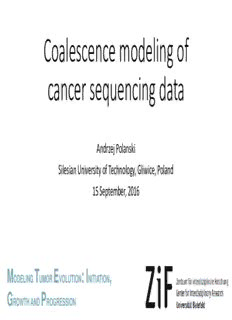
Coalescence modeling of cancer sequencing data PDF
Preview Coalescence modeling of cancer sequencing data
Coalescence modeling of cancer sequencing data Andrzej Polanski Silesian University of Technology, Gliwice, Poland 15 September, 2016 M T E : I , ODELING UMOR VOLUTION NITIATION G P ROWTH AND ROGRESSION PLAN • Coalescent model • Motivation for use in cancer sequencing data • Methods • Results • Conclusions What is coalescent model ? Coalescent is a mathematical tool for modeling phylogenetic trees of samples drawn from evolving populations. It has been used for statistical inference on genetic parameters and structures of evolving populations. What is coalescent model ? • Kingman J.F.C. , (1982), The Coalescent, Stoch. Proc. Appl., vol. 13, pp. 235-248, 1982. • Kimura M, (1983), The neutral theory of molecular evolution, Cambridge (UK): Cambridge University Press. Wright-Fisher model of reproduction Genetic drift Individuals = fragments of DNA Generations Alleles: A : A : 1 2 Reproduction = DNA replication = sampling with replacement G 1 Hypotheses: • Discrete, non-overlapping generations • Haploid individuals or diploid population G 2 with panmixia = random mating) ... • Constant population size • No selection (all individuals are equally fit) G • No recombination n • No substructure (no geographical structure) ... Wright-Fisher model: reproduction + mutation Mutation G k introduces genetic variability to the evolution process • Poisson process with intensity measured per locus (per site) per generation. Spatial characterization of places and effects caused, further specifies a mutation model. Most often G applied: k+1 Infinite sites model, where it is assumed that each mutation takes place at a DNA site that never mutated before; Coalescent approach One looks at the past of an n - sample of sequences taken at present. Possible events that happen in the past are coalescences leading to common ancestors of sequences, and mutations along branches of ancestral tree. Coalescent approach G 1 s t 2 2 G 2 ... s t 3 3 t s 4 4 G n s t 5 5 1 2 3 4 5 1 2 3 4 5 Coalescent versus other approaches Analytical results Coalescent Coalescent simulations Branching processes Forward random simulations Coalescent Changing population size Coalescent Selection Substructure
Description: